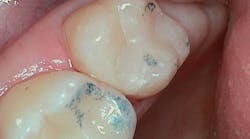Instagram: @jasonboeskin.dmd
Facebook: @jason.boeskin
The gist:
Thanks to recent advancements in dental composite technology and a simplified technique, dentists can now provide natural-looking direct posterior restorations quickly and easily, using a streamlined and efficient workflow.
In this case, conservative caries removal allowed the clinician to maximize bond strength while minimizing pulpal trauma and reduce the risk of exposure in a vital asymptomatic tooth.
Restoring the proximal wall initially allows more time for the dentin bond to mature before adding subsequent dentin replacement layers, thus lessening polymerization stress. Preoperative radiographs of the affected tooth were taken, confirming deep initial decay on tooth no. 15 (figure 1). An ideal restorative environment and isolation were achieved with a rubber dam. A light blue Isodam (Four D) was utilized, which provides better visual clarity and light reflection. The Isodam was anchored with a W8A clamp (Hu-Friedy) for better restorative access when placing sectional matrices after cavity preparation(figure 2).Methodic caries removal using traditional techniques with a high-speed pear diamond was utilized. Gross removal of outer carious dentin and approaching inner carious dentin was accomplished with a high-speed round diamond. As inner caries dentin was reached, the Caries Detector (Kuraray Noritake) was utilized for a visual aid in caries removal. Once a clean peripheral seal zone was achieved, the cavosurface was smoothed with a flame-shaped finishing carbide in the interproximal and a football-shaped carbide for the occlusal (figure 3).
Next, a sectional matrix (Garrison Dental) was placed and burnished with a spoon to facilitate a broad adaptation of the band to the adjacent tooth (figure 4). A Palodent V3 ring (Dentsply Sirona) was placed for separation and to ensure a tight resultant contact.
Clearfil Majesty ES-2 Universal composite (Kuraray Noritake) was selected as the restorative material. It provides easy adaptation due to its creamy consistency that prevents adherence to instruments. This composite material maintains its shape and contours prior to curing, allowing the clinician to create anatomy during placement. As this composite is a universal shade, it allows theSelective-etch technique was employed on the exposed and uncut enamel, followed by an application of Clearfil SE Protect Primer and Clearfil SE Bond. The bonding agent was lightly thinned with air and cured. The composite was placed along the dentin and proximal box margins to achieve a seal around the matrix band.
(figure 6). Editor's note:This article appeared in the July 2021 print edition ofDental Economics.
Jason Boeskin, DMD, is a 2017 graduate of A.T. Still University. He practices in Yuma, Arizona, focusing on CEREC and conservative preparation and bonding techniques, as well as traditional restorative dentistry.













